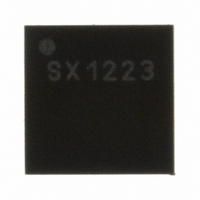SX1223I073TRT Semtech, SX1223I073TRT Datasheet - Page 15

SX1223I073TRT
Manufacturer Part Number
SX1223I073TRT
Description
IC TX UHF 433/868/916 MHZ 24TQFN
Manufacturer
Semtech
Datasheet
1.SX1223SK433.pdf
(25 pages)
Specifications of SX1223I073TRT
Frequency
425 ~ 475MHz / 850 ~ 950MHz
Applications
AMR, Home Automation, HQ Music and Data
Modulation Or Protocol
FSK
Data Rate - Maximum
153.6 kbps
Power - Output
10dBm
Current - Transmitting
25.8mA
Data Interface
PCB, Surface Mount
Antenna Connector
PCB, Surface Mount
Voltage - Supply
2 V ~ 3.6 V
Operating Temperature
-40°C ~ 85°C
Package / Case
24-TQFN
Lead Free Status / RoHS Status
Lead free / RoHS Compliant
Features
-
Memory Size
-
Other names
SX1223I073TR
5
5.1
A 3-wire bi-directional bus (SCK, SI, SO) is used to communicate with SX1223 and gives access to the
configuration register. SCK and SI are input signals supplied externally, for example by the microcontroller. The
SX1223 configures the SO signal as an output pin during read operation, and it is tri-stated in other modes. The
falling edge of the SCK signal is used to sample the SI pin to write data into the internal shift register of the SX1223.
The rising edge of the SCK signal is used to output data by the SX1223 to the SO pin, so the microcontroller should
sample data at the falling edge of SCK. Be aware that reading data on SO output is forbidden whilst in transmit
mode.
The signal EN must be low during the whole write and read sequences. In write mode the actual content of the
configuration register is updated at the rising edge of the EN signal. Before this, the new data is stored in temporary
registers whose content does not affect the transceiver settings.
The timing diagram of a write sequence is given in Figure 7 below. The sequence is initiated when a Start condition
is detected, that is when the SI signal is set to “0” during a period of SCK. The next bit is a read/write (R/W) bit
which should be “0” to indicate a write operation. The next 5 bits are the address of the control register A[4:0] to be
accessed, MSB first. Then, the next 8 bits are the data to be written in the register. The data on SI should change at
the rising edges of SCK, and is sampled at the falling edge of SCK. The SI line should be at “1” for at least one
clock cycle on SCK before a new write or read sequence can start. In doing this, users can do multiple registers
write without a rising EN signal in between. The duty cycle of SCK must be between 40% and 60% and the
maximum frequency of this signal is 1 MHz. Over the operating supply and temperature range, set-up and hold time
for SI on the falling edge of SCK are 200ns.
The time diagram of a read sequence is given in figure below. The sequence is initiated when a Start condition is
detected, that is when the SI signal is set to “0” during a period of SCK. The next bit is a read/write (R/W) bit which
should be “1” to indicate a read operation. The next 5 bits are the address of the control register A[4:0] to be
accessed, MSB first. Then the data from the register are transmitted on the SO pin. The data become valid at the
rising edges of SCK and should be sampled at the falling edge of SCK. After this, the data transfer is terminated.
The SI line must stay high for at least one clock cycle on SCK to start a new write or read sequence. The typical
current drive on SO is 2mA @ 2.7V, the maximum load is CLop.
When the serial interface is not used for read or write operations, both SCK and SI should be set to “1”. Except in
read mode, SO is set to “HZ”.
© Semtech 2007
SERIAL INTERFACE DEFINITION AND PRINCIPLES OF OPERATION
SERIAL CONTROL INTERFACE
EN
SO
SI
SCK
A4
Figure 7: Write sequence into configuration register
A3
A2
HZ
A1
A0
15
D7
D6
D5
D4
D3
D2
D1
D0
www.semtech.com
SX1223












